The Church Saint-Pierre and Saint-Paul of Comps
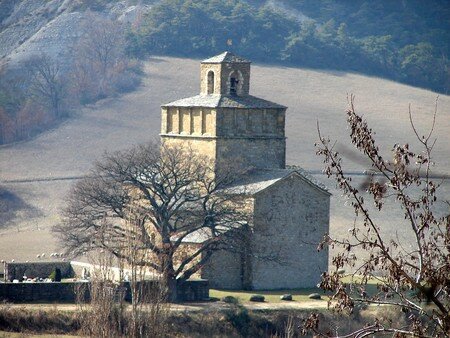 According
to the legend, a Lord of Comps which drove out is one day mislaid on
the hill covered with wood. He knelt and swore in front of God that if
he managed to leave himself there alive, he would build a vault on the
site where he was…
According
to the legend, a Lord of Comps which drove out is one day mislaid on
the hill covered with wood. He knelt and swore in front of God that if
he managed to leave himself there alive, he would build a vault on the
site where he was…
And it held word.
 When I arrived, I was accomodated by some horses. The church appeared to me through the trees. Beautiful introduction…
When I arrived, I was accomodated by some horses. The church appeared to me through the trees. Beautiful introduction…
 This
priory is superbly isolated on a small headland, in front of a broad
landscape. One is astonished by this building in Greek cross.
This
priory is superbly isolated on a small headland, in front of a broad
landscape. One is astonished by this building in Greek cross.
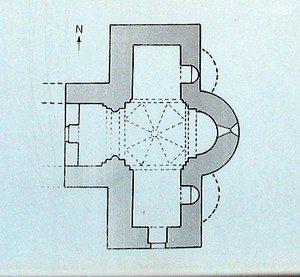 At
last century, the Jouve canon had seen an Eastern influence in the plan
in Greek cross and A.Lacroix, taking up this idea, had deduced from it
that it had being built with the return of the first crusade. It is
quite simply about a church whose nave and bell-tower remained
unfinished.
At
last century, the Jouve canon had seen an Eastern influence in the plan
in Greek cross and A.Lacroix, taking up this idea, had deduced from it
that it had being built with the return of the first crusade. It is
quite simply about a church whose nave and bell-tower remained
unfinished.
 A
church existed before the current church. Comps was in 1031 the seat of
a “vicaria”, or viguery, civil division old, which depended on the Holy
roman Empire Romain Germanique. It depended on the Benedictine abbey
of Savigny, close to Arbresle, in the Rhone (which is quoted in a
donation of 1032). This abbey had also the churches of Bézaudun,
Bourdeaux and Crupies. It is what explains the importance of its
Saint-Paul church.
A
church existed before the current church. Comps was in 1031 the seat of
a “vicaria”, or viguery, civil division old, which depended on the Holy
roman Empire Romain Germanique. It depended on the Benedictine abbey
of Savigny, close to Arbresle, in the Rhone (which is quoted in a
donation of 1032). This abbey had also the churches of Bézaudun,
Bourdeaux and Crupies. It is what explains the importance of its
Saint-Paul church.
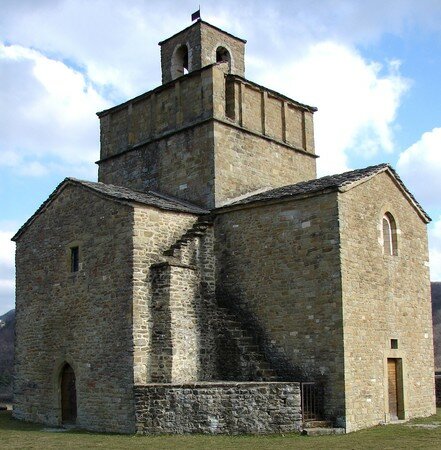 The
seigniory of Comps pledged by was probably évêché of Valentinois in
reward of the services rendered by the family of Comps to the crusades,
in particular that of 1095 in which took part Odon de Comps.
The
seigniory of Comps pledged by was probably évêché of Valentinois in
reward of the services rendered by the family of Comps to the crusades,
in particular that of 1095 in which took part Odon de Comps.
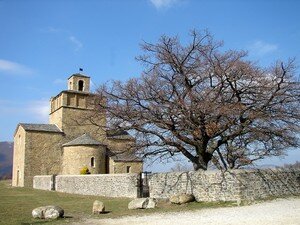 The
church is still quoted like a dependence of Savigny at the beginning of
the XII ème century in 1107, by the pope Pascal II, but, on an unknown
date, perhaps to the XIII ème century, the priory of Comps passes to
the Augustins canons of the abbey of Saoû.
The
church is still quoted like a dependence of Savigny at the beginning of
the XII ème century in 1107, by the pope Pascal II, but, on an unknown
date, perhaps to the XIII ème century, the priory of Comps passes to
the Augustins canons of the abbey of Saoû.
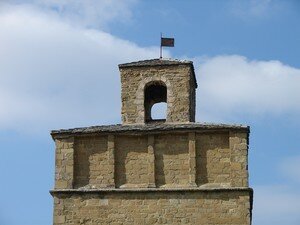 The
seigniory of Comps was a stronghold of the counts Valentinois. The
first, Aymar, were the natural son of Guillaume IX, count de Poitiers
about 1120. The family of Comps died out with the XIII ème century has
by the marriage of the last heiress with Dalmas I of Vesc. Its
descendants thus became lords of Comps and Dieulefit.
The
seigniory of Comps was a stronghold of the counts Valentinois. The
first, Aymar, were the natural son of Guillaume IX, count de Poitiers
about 1120. The family of Comps died out with the XIII ème century has
by the marriage of the last heiress with Dalmas I of Vesc. Its
descendants thus became lords of Comps and Dieulefit.
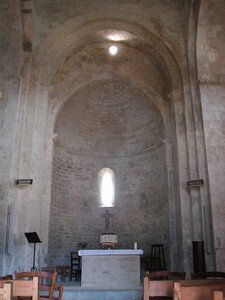 At
the time of a visit in 1509, the bishop of Valence and Die authorizes
his enlarging and orders the repair of the gate and the glazing to the
top of the door of entry. In 1534, the inhabitants of Comps lend his
bell to those of Dieulefit.
At
the time of a visit in 1509, the bishop of Valence and Die authorizes
his enlarging and orders the repair of the gate and the glazing to the
top of the door of entry. In 1534, the inhabitants of Comps lend his
bell to those of Dieulefit.
The church was classified historic building in 1938. In 1947, its roof entirely was remade and covered with slate roofing stones. The adjacent building, presbytery and school, were destroyed.
The single nave, broad 5,10 m 3,89 m is long only.
You will notice the occulus slightly shifted on the line. A dedication, or a chock on a star?
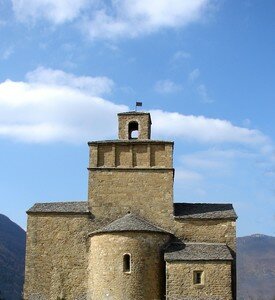 The
outside is built in small regular sandstone apparatus. In the facing,
in the south of the semicircular apse, one guesses that a southernmost
absidiole disappeared, the northern absidiole being replaced by a vault
with ribbed vault of XVe century. A door, perhaps of XIVe century,
opens in the west in the embryo of nave. The stock of the solid
bell-tower is reinforced naked pilasters intended to carry an element
which existed forever. Inside, which strikes, it is the height of the
vaults, in particular of the cupola carried by the arcs of framing of
crossed and by their pilasters with multiple splash plates. Side of the
nave the arc falls down on two imbedded columns, that of the south
having an only outlined base. The nave is reduced to a small span and
one recognizes in the pilot wheels the entries of the absidioles.
The
outside is built in small regular sandstone apparatus. In the facing,
in the south of the semicircular apse, one guesses that a southernmost
absidiole disappeared, the northern absidiole being replaced by a vault
with ribbed vault of XVe century. A door, perhaps of XIVe century,
opens in the west in the embryo of nave. The stock of the solid
bell-tower is reinforced naked pilasters intended to carry an element
which existed forever. Inside, which strikes, it is the height of the
vaults, in particular of the cupola carried by the arcs of framing of
crossed and by their pilasters with multiple splash plates. Side of the
nave the arc falls down on two imbedded columns, that of the south
having an only outlined base. The nave is reduced to a small span and
one recognizes in the pilot wheels the entries of the absidioles.
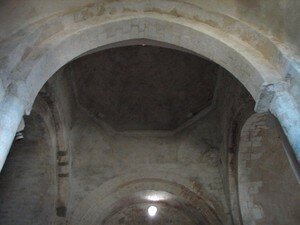 The
cupola passes from the basic rectangle to the octagone thanks to broad
horns where XIXe had placed reasons. The moulding in quarter of round
which runs to the bottom of the octagone, the perfection and the width
of the cupola, the broken layout of the arcs of framing and the vaults
assign at the building one posterior time in the middle of XIIe century.
The
cupola passes from the basic rectangle to the octagone thanks to broad
horns where XIXe had placed reasons. The moulding in quarter of round
which runs to the bottom of the octagone, the perfection and the width
of the cupola, the broken layout of the arcs of framing and the vaults
assign at the building one posterior time in the middle of XIIe century.
The site in itself cuts the breath. The beauty and elegance are of setting. Unfortunately, or fortunately, the entry of the church remains closed throughout the year, except during the day of the inheritance. The least worse, it is that one can open the door and take some photographs through a grid…
http://www.centcols.org/les_rendez-vous/damian/monuments_romans_suite.htm

/https%3A%2F%2Fprofilepics.canalblog.com%2Fprofilepics%2F1%2F1%2F116167.jpg)
/https%3A%2F%2Fstorage.canalblog.com%2F49%2F16%2F312499%2F14620054_o.jpg)
/https%3A%2F%2Fstorage.canalblog.com%2F53%2F18%2F312499%2F14151229_o.jpg)
/https%3A%2F%2Fstorage.canalblog.com%2F07%2F05%2F312499%2F14149867_o.jpg)
/https%3A%2F%2Fstorage.canalblog.com%2F11%2F35%2F312499%2F14149307_o.jpg)
/https%3A%2F%2Fstorage.canalblog.com%2F90%2F14%2F312499%2F14125247_o.jpg)


/https%3A%2F%2Fstorage.canalblog.com%2F12%2F98%2F137895%2F6624411_p.jpg)
/https%3A%2F%2Fstorage.canalblog.com%2F34%2F82%2F137895%2F27207854_p.jpg)
/https%3A%2F%2Fstorage.canalblog.com%2F32%2F37%2F137895%2F15872299_p.jpg)
/https%3A%2F%2Fstorage.canalblog.com%2F37%2F81%2F137895%2F15879822_p.jpg)